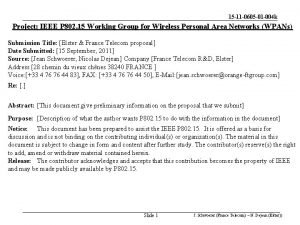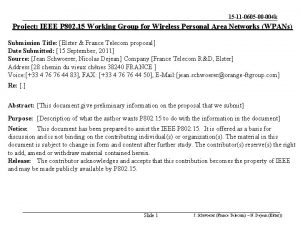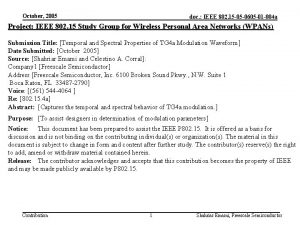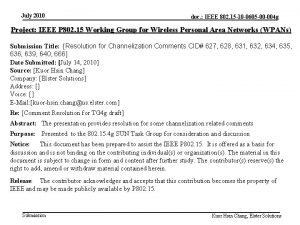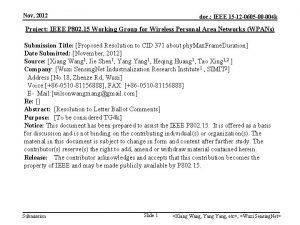IEEE 802 15 13 0605 00 004 n







- Slides: 7

IEEE 802. 15 -13 -0605 -00 -004 n Project: IEEE P 802. 15 Working Group for Wireless Personal Area Networks (WPANs) Submission Title: Proposal of Eye Diagram for CMB GFSK PHY Date Submitted: May , 2013 Source: Kenichi Mori (mori. ken 1@jp. panasonic. com), Panasonic; Shinsuke Hara (shinsukehara 0122@gmail. com ), Qo. L-SN; Masahiro Kuroda (marsh@nict. go. jp), Qo. L-SN&NICT; Abstract: PSD calculation result of GFSK PHY for 15. 4 n Purpose: Clarification of PSD of GFSK Notice: This document has been prepared to assist the IEEE P 802. 15. It is offered as a basis for discussion and is not binding on the contributing individual(s) or organization(s). The material in this document is subject to change in form and content after further study. The contributor(s) reserve(s) the right to add, amend or withdraw material contained herein. Release: The contributor acknowledges and accepts that this contribution becomes the property of IEEE and may be made publicly available by P 802. 15. Submission 1

IEEE 802. 15 -13 -0605 -00 -004 n Abstract • Proposal of Eye diagram for CMB GFSK PHY - Frequency deviation tolerance - Zero crossing tolerance TBD 1% TBD 2% -TBD 3% Ts TBD 2% TBD 1% Submission 2

IEEE 802. 15 -13 -0605 -00 -004 n Background • The latest specification draft has TBD values for frequency deviation tolerance and zero crossing tolerance as shown the next. 21. 2. 2. 5 Frequency deviation tolerance Modulation frequency tolerance is measured as a percentage of the frequency deviation, fdev, dictated by the modulation index. In the case of filtered 2 FSK, the measured frequency deviation, f, at Ts / 2 shall be constrained to the range TBD% fdev < |f| < TBD% fdev, as shown in Figure 21. 24, where Ts is the symbol time. 21. 2. 2. 6 Zero crossing tolerance In the case of filtered 2 FSK, the excursions for the zero crossings for all trajectories of the eye diagram shall be constrained to within ±TBD% of the symbol time Ts, as shown in Figure 21. 24. => Need to fix these values Submission 3

IEEE 802. 15 -13 -0605 -00 -004 n Parameters Influence Eye Diagram Example parameters influence eye diagram are PLL Synthesizer • VCO Phase noise • Charge pump noise • Delta-Sigma circuit noise (in case of fractional synthesizer) • PLL loop filter characteristics etc. Others • Parts to parts variation • Voltage variation • Temperature variation etc. These parameters are determined considering target data rate, usage environment and so on. Target data rate, up to 200 kbps, is similar to 15. 4 g. How about temperature? Submission 4

IEEE 802. 15 -13 -0605 -00 -004 n Usage condition of CMB devices One of the main applications of IEEE 802. 15. 4 g is a smart meter which may be used outdoor condition. Hence -45 - +85 operation temperature range is considered in devices compliant with IEEE 802. 15. 4 g. Target applications of CMB are as below. (see DCN 15 -12 -539 r 0) • Hospital and Clinics • Medical Instruments continuous monitoring • Medical instrument management in hospital (See next slide for examples, etc) • Therapy management • Home • Medical Data collection and download • Exercising and sport equipment data • Senior movement detection and location tracking Some data collector devices may be placed in outdoor as the worst case. Hence, it is better to reuse the eye diagram adopted by IEEE 802. 15. 4 g to support those possible worst condition. Submission 5

IEEE 802. 15 -13 -0605 -00 -004 n Eye diagram proposal ・same as the IEEE 802. 15. 4 g eye diagram Submission 6

IEEE 802. 15 -13 -0605 -00 -004 n Conclusion 21. 2. 2. 5 Frequency deviation tolerance Modulation frequency tolerance is measured as a percentage of the frequency deviation, fdev, dictated by the modulation index. In the case of filtered 2 FSK, the measured frequency deviation, f, at Ts / 2 shall be constrained to the range 70% fdev < |f| < 130% fdev, as shown in Figure 21. 24, where Ts is the symbol time. 21. 2. 2. 6 Zero crossing tolerance In the case of filtered 2 FSK, the excursions for the zero crossings for all trajectories of the eye diagram shall be constrained to within ± 12. 5% of the symbol time Ts, as shown in Figure 21. 24. Submission 7








